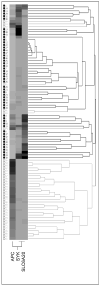DNA methylation profile of 28 potential marker loci in malignant mesothelioma
- PMID: 17659810
- PMCID: PMC2752414
- DOI: 10.1016/j.lungcan.2007.06.015
DNA methylation profile of 28 potential marker loci in malignant mesothelioma
Abstract
Patients with malignant mesothelioma (MM), an aggressive cancer associated with asbestos exposure, usually present clinically with advanced disease and this greatly reduces the likelihood of curative treatment. MM is difficult to diagnose without invasive techniques; the development of non-invasively detectable molecular markers would therefore be highly beneficial. DNA methylation changes in cancer cells provide powerful markers that are potentially detectable non-invasively in DNA shed into bodily fluids. Here we examined the methylation status of 28 loci in 52 MM tumors to investigate their potential as molecular markers for MM. To exclude candidate MM markers that might be positive in biopsies/pleural fluid due to contaminating surrounding non-tumor lung tissue/DNA, we also examined the methylation of these markers in lung samples (age- or environmentally induced hypermethylation is frequently observed in non-cancerous lung). Statistically significantly increased methylation in MM versus non-tumor lung samples was found for estrogen receptor 1 (ESR1; p = 0.0002), solute carrier family 6 member 20 (SLC6A20; p = 0.0022) and spleen tyrosine kinase (SYK; p=0.0003). Examination of associations between methylation levels of the 28 loci and clinical parameters suggest associations of the methylation status of metallothionein genes with gender, histology, asbestos exposure, and lymph node involvement, and the methylation status of leucine zipper tumor suppressor 1 (LZTS1) and SLC6A20 with survival.
Conflict of interest statement
Conflict of interest statement
I.A.L.-O. and P.W.L. are shareholders of Epigenomics AG, which has a commercial interest in the development of DNA markers for disease detection and diagnosis. None of the work performed in the laboratories of any of the authors is or has been supported by Epigenomics.
Figures




Similar articles
-
Aberrant DNA methylation profile in pleural fluid for differential diagnosis of malignant pleural mesothelioma.Cancer Sci. 2012 Mar;103(3):510-4. doi: 10.1111/j.1349-7006.2011.02180.x. Epub 2012 Jan 13. Cancer Sci. 2012. PMID: 22146010 Free PMC article.
-
Distinct DNA methylation profiles in malignant mesothelioma, lung adenocarcinoma, and non-tumor lung.Lung Cancer. 2005 Feb;47(2):193-204. doi: 10.1016/j.lungcan.2004.08.003. Lung Cancer. 2005. PMID: 15639718
-
Peripheral Blood DNA Methylation as Potential Biomarker of Malignant Pleural Mesothelioma in Asbestos-Exposed Subjects.J Thorac Oncol. 2019 Mar;14(3):527-539. doi: 10.1016/j.jtho.2018.10.163. Epub 2018 Nov 5. J Thorac Oncol. 2019. PMID: 30408567
-
Circulating epigenetic biomarkers in lung malignancies: From early diagnosis to therapy.Lung Cancer. 2017 May;107:65-72. doi: 10.1016/j.lungcan.2016.05.023. Epub 2016 Jun 2. Lung Cancer. 2017. PMID: 27312601 Review.
-
Advances in the molecular biology of malignant mesothelioma.Acta Med Okayama. 2008 Feb;62(1):1-7. doi: 10.18926/AMO/30990. Acta Med Okayama. 2008. PMID: 18323865 Review.
Cited by
-
Aberrant DNA methylation profile in pleural fluid for differential diagnosis of malignant pleural mesothelioma.Cancer Sci. 2012 Mar;103(3):510-4. doi: 10.1111/j.1349-7006.2011.02180.x. Epub 2012 Jan 13. Cancer Sci. 2012. PMID: 22146010 Free PMC article.
-
The Molecular Basis of Malignant Pleural Mesothelioma.Thorac Surg Clin. 2020 Nov;30(4):383-393. doi: 10.1016/j.thorsurg.2020.08.005. Epub 2020 Sep 12. Thorac Surg Clin. 2020. PMID: 33012428 Free PMC article. Review.
-
Quality assessment of DNA derived from up to 30 years old formalin fixed paraffin embedded (FFPE) tissue for PCR-based methylation analysis using SMART-MSP and MS-HRM.BMC Cancer. 2009 Dec 21;9:453. doi: 10.1186/1471-2407-9-453. BMC Cancer. 2009. PMID: 20025721 Free PMC article.
-
Asbestos exposure predicts cell cycle control gene promoter methylation in pleural mesothelioma.Carcinogenesis. 2008 Aug;29(8):1555-9. doi: 10.1093/carcin/bgn059. Epub 2008 Feb 28. Carcinogenesis. 2008. PMID: 18310086 Free PMC article.
-
Methylation of multiple genes in hepatitis C virus associated hepatocellular carcinoma.J Adv Res. 2014 Jan;5(1):27-40. doi: 10.1016/j.jare.2012.11.002. Epub 2013 Jan 26. J Adv Res. 2014. PMID: 25685469 Free PMC article.
References
-
- Murthy SS, Testa JR. Asbestos, chromosomal deletions, and tumor suppressor gene alterations in human malignant mesothelioma. J Cell Physiol. 1999;180:150–157. - PubMed
-
- Kazan-Allen L. Asbestos and mesothelioma: worldwide trends. Lung Cancer. 2005;49 Suppl 1:S3–8. - PubMed
-
- Boylan AM. Mesothelioma: new concepts in diagnosis and management. Curr Opin Pulm Med. 2000;6:157–163. - PubMed
Publication types
MeSH terms
Substances
Grants and funding
LinkOut - more resources
Full Text Sources
Other Literature Sources
Medical
Miscellaneous

